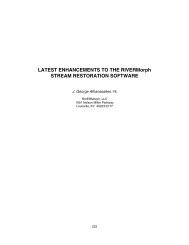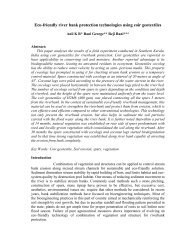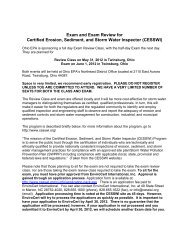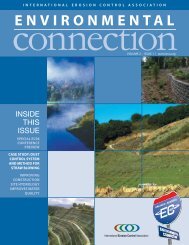ENVIRONMENTAL - International Erosion Control Association
ENVIRONMENTAL - International Erosion Control Association
ENVIRONMENTAL - International Erosion Control Association
You also want an ePaper? Increase the reach of your titles
YUMPU automatically turns print PDFs into web optimized ePapers that Google loves.
Using an <strong>Erosion</strong> Model for Designing Roads That Reduce Soil Losses in the Forest<br />
Figures 4 and 5 illustrate the equipment used to collect runoff and sediment from slopes for the<br />
portion of the research conducted in the Talladega National Forest in Alabama, USA. This study<br />
examined the effect of native and exotic vegetation and a Rolled <strong>Erosion</strong> <strong>Control</strong> Product for controlling<br />
erosion and on the road slopes. The plastic pipes collected all the runoff and sediment from<br />
each of four plots, located on the slopes at each site, and directed it to the blue storage containers. The<br />
researchers measured the amount of runoff and sediment collected in each container.<br />
Figure 4. Photo Credit: Johnny M. Grace, III.<br />
researchers measured sediment and<br />
runoff amounts from 164-ft. (50-m)<br />
long sections of the road following<br />
eight storm events over a 12-month<br />
period. Precipitation for each of the<br />
storms ranged from .1 in. to 5.5 (2.5<br />
mm to 140.2 mm).<br />
WEPP predictions of sediment<br />
yields for the simulated storms were<br />
consistent with measurements made at<br />
the study sites. “The results indicate a<br />
strong, but not a one-to-one, relationship<br />
between predicted and observed<br />
sediment yield for the road sections,”<br />
Grace says. “However, predictions of<br />
runoff yields were not nearly as good.<br />
This is likely due to the inability of<br />
adequately describing the effective<br />
hydraulic conductivity and soil texture<br />
to optimize sediment and runoff<br />
yields predictions simultaneously.”<br />
That, in turn, indicates the need<br />
for additional field data and studies,<br />
he notes. “We want to take a more detailed<br />
look at some of the factors that<br />
may be affecting runoff yields, such<br />
as hydraulic conductivity and how it<br />
differs with different road surfaces,”<br />
Grace says. “Studies by the Forest<br />
Service’s Rocky Mountain Research<br />
Station in Colorado indicate that hydraulic<br />
conductivity may be considerably<br />
higher than previously thought.”<br />
Figure 5. Photo Credit: Johnny M. Grace, III.<br />
The Next Step<br />
After confi rming the ability of<br />
WEPP to predict sediment and runoff<br />
in the two forests involved in this<br />
project fairly accurately, Grace is now<br />
looking at applying it to other forests<br />
in the Appalachian Mountains,<br />
coastal plains and piedmont areas of<br />
the Southeast.<br />
The Rocky Mountain Research Station<br />
has done a lot work in validating<br />
WEPP for conditions in the western<br />
United States, he notes. His research<br />
will help fi ll in a knowledge gap concerning<br />
its validity in the Southeast.<br />
“Assuming WEPP is valid in these<br />
areas, forest managers will be able to<br />
use it compare different erosion control<br />
scenarios before designing and<br />
building roads.”<br />
Grace’s technical paper is available<br />
at www.ieca.org > Information > Proceedings<br />
2007 to present.<br />
24 • <strong>ENVIRONMENTAL</strong> CONNECTION













